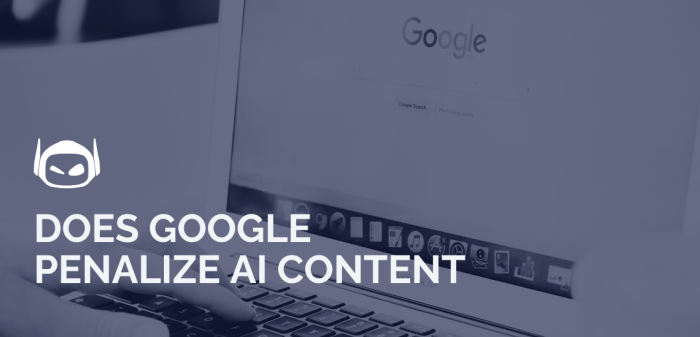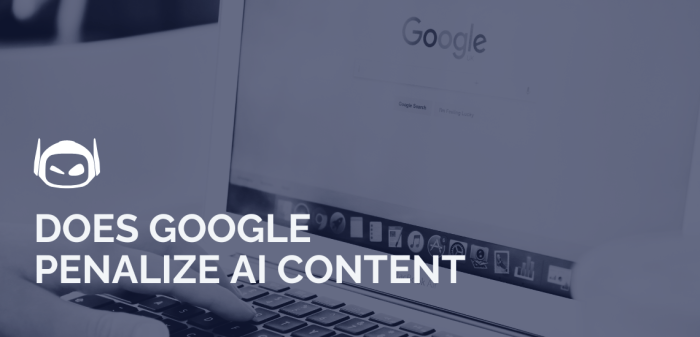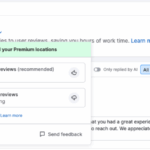Does Google penalize AI content? This crucial question is at the forefront of the evolving digital landscape. AI-generated content is rapidly becoming more prevalent, raising concerns about its impact on search engine rankings. This in-depth exploration investigates Google’s policies, potential penalties, and strategies to create AI-generated content that avoids repercussions.
Understanding Google’s perspective on AI-generated content is essential for content creators and businesses utilizing this technology. This article examines various aspects of AI content, including its definition, characteristics, and how it compares to human-written content. We’ll analyze Google’s content policies and guidelines, identifying potential pitfalls and providing practical advice on how to navigate this complex area.
Defining AI Content

AI-generated content is rapidly changing the landscape of information creation. Understanding what constitutes AI content, its different forms, and how it compares to human-created content is crucial for navigating this new information paradigm. This involves recognizing the distinct characteristics of AI-generated material and the various methods used to produce it.AI content is any form of information created by artificial intelligence (AI) systems, algorithms, or models.
This encompasses a wide spectrum of output, from simple text strings to complex multimedia creations. It relies on patterns and data learned from vast datasets to generate new content, often mimicking human creativity in style and form.
Types of AI Content
AI content spans diverse media formats. It’s not limited to a single type of output. Recognizing these varied forms is key to understanding the breadth of AI’s capabilities.
- Text-based content: AI can generate articles, blog posts, scripts, poems, and even code. This text may replicate human writing styles, but it is ultimately created by algorithms processing vast amounts of data.
- Image-based content: AI algorithms can produce images, photos, and artwork, using styles and themes learned from massive image datasets. These creations can range from simple graphics to complex artistic representations.
- Audio content: AI can generate music, sound effects, and even speech. AI-generated voices can be used for narration, voiceovers, or even creating unique soundtracks.
- Video content: AI can generate video content, such as short clips, animations, and even entire movies. AI can help with editing, special effects, and story creation. This is particularly evident in the production of educational videos or explainer videos.
- Code-based content: AI tools can assist in creating and modifying code, enabling programmers to accelerate development and optimize software efficiency. AI can generate code snippets for common tasks or assist in fixing errors in codebases.
AI-Generated Content vs. Human-Written Content
Distinguishing between AI-generated and human-written content can sometimes be challenging. While AI excels at mimicking human style, it lacks the emotional depth and unique perspective often found in human-created content.
| Feature | AI-Generated Content | Human-Written Content |
|---|---|---|
| Origin | Created by algorithms and models | Created by humans |
| Perspective | Based on patterns in data | Based on individual experiences, thoughts, and emotions |
| Creativity | Mimics human creativity, but doesn’t possess genuine creativity | Characterized by originality, uniqueness, and a distinct voice |
| Style | Can replicate styles from vast datasets | Reflects unique writing style and tone |
| Error Rate | Can contain factual inaccuracies or inconsistencies, particularly if training data is flawed | Generally more accurate, given the author’s understanding and research |
Methods of AI Content Creation
Several methods are employed to generate AI content. Understanding these processes allows for a deeper comprehension of how AI tools work.
- Large Language Models (LLMs): These models are trained on massive text datasets, enabling them to generate human-like text. LLMs predict the next word in a sequence based on the context.
- Generative Adversarial Networks (GANs): GANs consist of two neural networks, one generating content and the other evaluating it. This iterative process refines the generated content. This is commonly used for creating realistic images and other forms of content.
- Transformer Networks: These networks excel at understanding the context of words and sentences. Transformers are particularly useful in generating text and translating languages.
- Image Recognition Models: These models are trained on vast datasets of images, enabling them to recognize objects, scenes, and styles. They are instrumental in creating new images.
Google’s Content Policies
Google’s content policies are designed to maintain a high-quality, trustworthy, and helpful search experience for users. These policies encompass a wide range of content types, from news articles and blog posts to product reviews and forum discussions. Understanding these policies is crucial for anyone creating content that aims to rank well in Google’s search results.
Google’s General Content Policies
Google’s general content policies prohibit content that is harmful, misleading, or violates the rights of others. This includes content that promotes illegal activities, spreads hate speech, or contains personal information without consent. The core principle is to ensure that the search results provide value to users and avoid exposure to potentially harmful content.
Guidelines for Evaluating Content Quality
Google uses a multifaceted approach to evaluate content quality. Factors considered include the information’s accuracy, authority, and usefulness. Well-researched, fact-checked information from reputable sources is generally favored. Freshness and up-to-date information are also important, particularly in fields like news and technology. The overall clarity and conciseness of the content also play a significant role in determining its quality.
Content should be presented in a way that is easy to understand for the target audience.
Google’s Approach to Ranking AI-Generated Content
Google’s approach to ranking AI-generated content is based on the same fundamental principles applied to human-written content. The quality and originality of the content are paramount. If the AI-generated content is well-researched, factually accurate, and provides unique insights, it is likely to rank well. Conversely, if the AI content is repetitive, plagiarized, or lacks originality, it may be penalized.
The emphasis is on the inherent quality of the content, not its origin.
Examples of Content Violating Google’s Policies
Examples of content that violate Google’s policies include:
- Spammy content that aims to manipulate search rankings by stuffing s or using deceptive tactics.
- Content that promotes misleading or false information, such as fake news or product reviews.
- Content that infringes on the intellectual property rights of others, such as copyright infringement.
- Content that promotes illegal activities or harmful products, including drugs or weapons.
These examples highlight the importance of ethical content creation to maintain a positive online environment.
Comparison of Human-Written and AI-Generated Content
The table below provides a comparative analysis of human-written and AI-generated content based on Google’s guidelines.
| Criteria | Human-Written Content | AI-Generated Content |
|---|---|---|
| Accuracy | Generally higher accuracy due to fact-checking and thorough research | Accuracy depends on the training data; potential for inaccuracies |
| Originality | Generally original and unique perspectives | May lack originality, especially if heavily reliant on existing sources |
| Clarity and Readability | Often more nuanced and engaging | Potentially repetitive or lacking in natural language flow |
| Freshness | Often reflects current events and developments | May not reflect current information if training data is outdated |
| Usefulness | Provides in-depth information and value | Value depends on the topic and the AI’s training |
This table illustrates the key differences between the two types of content and how Google might evaluate them.
Identifying Potential Penalties
AI-generated content, while rapidly evolving, presents unique challenges for search engines like Google. Distinguishing between genuine human-created content and AI-produced text requires sophisticated algorithms, and deviations from Google’s quality guidelines can lead to penalties. Understanding the potential penalties is crucial for creators using AI tools to ensure their content remains discoverable and maintains a positive online presence.Google’s approach to penalizing AI-generated content isn’t explicitly stated, but patterns suggest a focus on content quality and user experience.
The penalties likely overlap with those applied to other forms of low-quality content, but unique considerations regarding AI tools and their potential to produce large volumes of content are emerging.
Potential Types of Penalties
Google’s response to problematic content varies, ranging from subtle algorithmic adjustments to more significant penalties like reduced visibility in search results or complete removal. Potential penalties might include decreased organic search rankings, decreased click-through rates, and reduced visibility in featured snippets. In severe cases, websites or content creators could face complete removal from Google’s index.
So, does Google penalize AI-generated content? The answer isn’t straightforward, but it’s clear that quality is key. A lot of the strategies used to create high-quality, engaging content, like using behaviorally targeted emails, for example, behaviorally targeted emails examples , can help avoid any potential penalties. Ultimately, focusing on providing valuable, original content will likely be the best approach to avoid any negative repercussions from Google.
Factors Influencing Penalty Decisions
Several factors influence Google’s decisions regarding penalties for AI-generated content. These factors include the originality and quality of the content, the presence of plagiarism, the presence of factual inaccuracies, the user experience, and the overall context of the website. Google likely evaluates the extent to which AI tools have been used to generate the content, alongside other factors influencing content quality.
Quick question: does Google penalize AI-generated content? The truth is, it’s a bit murky. To build a strong online presence, regardless of content creation methods, focusing on high-quality, user-centric landing pages is key. Using tools like 12 tools that can help you build high converting landing pages can significantly improve your site’s performance. Ultimately, Google’s algorithms are complex, and adhering to best practices for both AI and human-written content is likely your best bet for avoiding any potential penalties.
Comparison with Penalties for Other Content Types
Penalties for AI-generated content share similarities with those applied to other types of low-quality content. For example, duplicate content, thin content, and content that fails to satisfy user intent are all subject to penalties. However, the sheer volume of AI-generated content and its potential for rapid generation of low-quality content necessitates a unique approach to detecting and penalizing such content.
AI-generated content that is plagiarized or factually inaccurate will likely face harsher penalties than other content issues, due to its potential impact on user experience and information quality.
Table of Common Issues Leading to Penalties
| Issue | Description | Potential Penalty |
|---|---|---|
| Duplicate Content | AI-generated content that is identical or substantially similar to other content online. | Reduced rankings, or removal from search results. |
| Thin Content | AI-generated content lacking sufficient depth, original analysis, or useful information for the user. | Reduced rankings, or decreased visibility. |
| Plagiarism | AI-generated content that copies content from other sources without proper attribution. | Reduced rankings, or removal from search results. |
| Factual Inaccuracies | AI-generated content that contains false or misleading information. | Reduced rankings, or removal from search results. |
| Poor User Experience | AI-generated content that is difficult to read, understand, or navigate. | Reduced rankings, or decreased visibility. |
| Lack of Originality | AI-generated content that lacks unique perspective or value. | Reduced rankings, or decreased visibility. |
Examples of AI Content and Penalties: Does Google Penalize Ai Content
AI-generated content is rapidly becoming a significant part of the online landscape. However, its proliferation has also raised concerns about its quality and potential for misuse. Google, as a leading search engine, has a responsibility to ensure that its results are accurate, trustworthy, and valuable to users. This necessitates a careful approach to evaluating and potentially penalizing AI-generated content.
Understanding the specific examples of penalized content, the reasons behind the penalties, and the evolution of Google’s stance is crucial for both AI content creators and users.Google’s policies on AI-generated content are not static; they are continuously evolving to address the challenges posed by this rapidly developing technology. The criteria for evaluating AI content, and consequently the potential for penalties, are complex and nuanced.
While the debate around Google penalizing AI-generated content rages on, a crucial aspect often overlooked is optimizing your content for search engines. Understanding how to improve your click-through rate (CTR) is key, and this guide provides nine actionable steps to boost your visibility. Ultimately, crafting engaging, human-quality content, regardless of its creation method, is more likely to avoid any potential penalties from Google, even if the AI question remains somewhat hazy.
This includes assessing originality, quality, and adherence to Google’s broader content policies.
Examples of Penalized AI Content
AI-generated content can be penalized for various reasons, including plagiarism, thin content, lack of originality, and a failure to meet Google’s quality guidelines. This is not a simple binary; the severity of the penalty often depends on the specific nature of the content and the extent of its non-compliance. Some examples of penalized content are often characterized by a lack of depth and originality, relying heavily on superficial or repetitive information.
Reasons for Penalties
Penalties for AI-generated content are typically issued when the content violates Google’s policies. These policies aim to ensure that search results provide valuable, original, and informative content. One key area of concern is the generation of content that is considered “thin” or “unoriginal.” Such content may simply be a collection of phrases and sentences without a significant underlying message or unique perspective.
Another aspect is the use of AI to create content that is essentially plagiarized or based on already-existing work without proper attribution. Google’s algorithms can often detect these patterns, leading to penalties.
Characteristics of Penalized vs. Non-Penalized AI Content
The difference between penalized and non-penalized AI content often lies in the quality and originality of the generated text. Non-penalized content usually demonstrates a clear purpose, unique perspective, and sufficient depth. In contrast, penalized content often lacks these characteristics, appearing as a superficial compilation of readily available information. The key distinction often revolves around the extent to which the AI content can be deemed as a genuine contribution to the existing body of knowledge.
Evolution of Google’s Stance
Google’s approach to AI-generated content has evolved over time, reflecting the growing sophistication of AI technology and the increasing prevalence of AI-generated content online. Initially, Google’s focus was on identifying and penalizing AI-generated content that violated existing policies, such as plagiarism. More recently, the emphasis has shifted towards encouraging the creation of high-quality AI content that aligns with Google’s broader content guidelines.
This implies that future penalties might be more nuanced and target specific aspects of AI content, rather than simply flagging any AI-generated output.
Potential Penalties for Different Types of AI-Generated Content
| Type of AI-Generated Content | Potential for Penalty |
|---|---|
| Automatically Generated Articles | High |
| AI-Generated Creative Writing (e.g., poetry, short stories) | Moderate to High, depending on originality |
| AI-Generated Product Descriptions | Moderate |
| AI-Generated Code | Low, but potential issues with plagiarism or infringement |
| AI-Generated Summaries | Moderate, if not sufficiently original |
This table provides a general overview of the potential for penalty based on the type of AI-generated content. The actual penalty will depend on various factors, including the quality of the content and its adherence to Google’s guidelines.
Factors Influencing Penalties

AI-generated content’s fate in Google’s search results hinges on a complex interplay of factors. Simply creating AI-written text doesn’t guarantee it will rank well or avoid penalties. Understanding these influencing elements is crucial for content creators utilizing AI tools. Google’s algorithm, constantly evolving, assesses various aspects of the content beyond just its origin.
Content Originality and Uniqueness
Content originality and uniqueness are paramount in Google’s eyes. AI content, while potentially efficient, often produces outputs that lack the distinctive voice and perspective of human-crafted material. When AI-generated content is near-identical to existing content or displays a lack of originality, it risks triggering penalties. This isn’t necessarily about plagiarism but rather a lack of unique insights and perspectives.
Content Quality and Relevance
Content quality and relevance are crucial for any content, especially AI-generated content. While AI can produce large volumes of text, it doesn’t inherently understand the nuances of human interest or search intent. Poorly written, inaccurate, or irrelevant content, regardless of its origin, will likely perform poorly in search results.
User Experience and Engagement Metrics
User experience and engagement metrics play a vital role in Google’s evaluation. AI content, if poorly constructed, might result in a poor user experience, reflected in metrics like bounce rate and time on page. Conversely, well-structured, engaging AI-generated content, tailored to user needs, can perform well.
Adherence to Google’s Quality Guidelines for AI-Generated Content
Google has not explicitly Artikeld specific guidelines for AI-generated content, but general quality guidelines apply. AI content creators should adhere to Google’s broader principles for high-quality content, focusing on clarity, accuracy, and user satisfaction. A content strategy that prioritizes these factors can significantly improve the chances of AI content performing well.
Table: Factors Influencing Penalties
| Factor | Description | Example |
|---|---|---|
| Content Originality | The degree to which the content is unique and not a duplicate or near-duplicate of existing content. | An AI-generated article that closely mirrors an existing article on the same topic. |
| Content Quality | The overall quality of the content, encompassing clarity, accuracy, and adherence to proper writing standards. | An AI-generated article riddled with grammatical errors and factual inaccuracies. |
| Content Relevance | The degree to which the content addresses the user’s search query and satisfies their information need. | An AI-generated article about gardening that is irrelevant to a user searching for “best laptop deals”. |
| User Experience | The user’s interaction with the content, including metrics like bounce rate, time on page, and click-through rate. | An AI-generated article with poor formatting or confusing structure, leading to high bounce rates. |
| Adherence to Google Quality Guidelines | Following Google’s general quality guidelines, including focusing on user satisfaction and accuracy. | An AI-generated article that prioritizes stuffing over clarity and relevance. |
Methods to Avoid Penalties
Navigating the ever-shifting sands of search engine optimization () can feel like a constant game of catch-up. Google’s algorithms are constantly evolving, and what worked yesterday might be penalized today. Understanding how to create AI-generated content that adheres to Google’s guidelines is crucial for long-term success. This section dives into actionable strategies to avoid those penalties.AI-generated content can be a powerful tool, but it needs careful handling.
Creating content that’s both helpful to users and adheres to Google’s quality guidelines is paramount. Avoiding plagiarism and focusing on originality, high-quality research, and a positive user experience are key elements in this process.
Originality and Avoiding Plagiarism
Ensuring originality is paramount when using AI tools. Simply rephrasing existing content won’t cut it. AI tools can be helpful in generating ideas, but the final product needs a unique perspective and a fresh approach. A strong emphasis on original thought and research is crucial. Plagiarism, in any form, will negatively impact your content’s ranking and potentially lead to penalties.
This involves not only avoiding direct copying but also understanding and appropriately referencing sources.
High-Quality and Well-Researched Content
High-quality content is a cornerstone of good practices, regardless of whether it’s AI-assisted or not. AI tools can help gather information, but the process of verifying, analyzing, and synthesizing that information falls squarely on the creator. Thorough research is essential to ensure the accuracy and relevance of the information presented. This involves fact-checking, considering multiple perspectives, and incorporating diverse sources.
The goal is to provide readers with insightful and valuable information that surpasses a simple aggregation of data.
Maintaining a Positive User Experience
A positive user experience (UX) is a crucial factor in Google’s ranking algorithms. AI-generated content should be easy to read, understand, and navigate. Avoid overly complex language, grammatical errors, and poor formatting. A user-friendly layout and engaging presentation are vital. If the content is difficult to read or understand, users will leave quickly, impacting your rankings negatively.
Improving the Quality of AI-Generated Content
AI tools can generate text, but they often lack the nuance and creativity of human writers. To improve the quality of AI-generated content, consider these strategies:
- Human review and editing are essential. AI outputs often need refinement to ensure clarity, flow, and originality. A human editor can catch errors, improve the tone, and ensure the content resonates with the target audience.
- Adding unique insights and perspectives can differentiate AI-generated content. By incorporating original analysis and commentary, you add value and make the content more compelling. Avoid simply summarizing existing information. Instead, offer a new perspective or interpretation.
- Incorporating multimedia elements, such as images, videos, and infographics, can enhance user engagement. Visual aids can help break up text, make complex information easier to understand, and keep users interested.
Steps to Create AI Content that Adheres to Google’s Policies, Does google penalize ai content
This table Artikels a structured approach to creating AI-generated content that aligns with Google’s quality guidelines.
| Step | Action |
|---|---|
| 1 | Define your target audience and content purpose. |
| 2 | Use AI tools to generate initial content drafts. |
| 3 | Thoroughly research and fact-check the information. |
| 4 | Ensure originality and avoid plagiarism. Paraphrase and cite sources appropriately. |
| 5 | Refine and edit the content for clarity, flow, and accuracy. |
| 6 | Incorporate diverse sources and perspectives. |
| 7 | Optimize for readability and user experience. |
| 8 | Regularly review and update the content for relevance and accuracy. |
Illustrative Scenarios
AI-generated content is rapidly changing the digital landscape, and Google’s approach to evaluating it is evolving. Understanding how Google might react to various AI-generated content scenarios is crucial for content creators and businesses leveraging AI tools. This section explores hypothetical situations and their potential outcomes.
Scenario 1: Plagiarized AI-Generated Content
AI tools can sometimes produce text that closely mirrors existing content without proper attribution. This poses a significant challenge to originality and authenticity. Google’s algorithms are designed to identify patterns and similarities in content, and plagiarism, even if generated by AI, violates their policies.
- Google’s Potential Actions: Google might flag the content for manual review, potentially leading to a manual action (a warning, suspension, or removal). It could also decrease the page’s ranking or visibility in search results.
- Factors Influencing Google’s Decision: The extent of the plagiarism, the source of the plagiarized content, and the overall quality of the website hosting the content would be critical factors in Google’s decision-making process.
- Potential Outcomes: The outcome could range from a warning and a few adjustments to a complete removal from search results. The severity of the penalty is directly related to the extent of the violation.
Scenario 2: AI-Generated Content with Inaccurate Information
AI models, while powerful, can sometimes generate factually incorrect or misleading content. This inaccuracy can harm users seeking reliable information.
- Google’s Potential Actions: Google might flag the content for manual review and potential penalties, ranging from warnings to de-ranking. If the inaccuracies are significant, the content could be removed from search results.
- Factors Influencing Google’s Decision: The severity of the inaccuracies, the potential harm to users, and the context of the information (e.g., medical advice, financial information) would heavily influence Google’s decision. The presence of clear citations and references could also play a role in mitigating the penalty.
- Potential Outcomes: The outcome could range from a low-impact penalty (e.g., a ranking drop) to a complete removal from search results. The severity of the penalty depends on the nature of the inaccuracy and its potential impact.
Scenario 3: AI-Generated Content with Low Originality
Even if AI-generated content isn’t explicitly plagiarized, it might lack originality and present a low-quality user experience.
- Google’s Potential Actions: Google might not directly penalize this content, but it could be less likely to rank it highly in search results. This is due to the emphasis on unique and high-quality content in Google’s search algorithm.
- Factors Influencing Google’s Decision: The overall quality of the content, including grammar, structure, and depth of information, will be critical. The relevance of the content to user searches also plays a significant role. Content that is thin, generic, or fails to offer unique insights may not perform well.
- Potential Outcomes: The primary outcome is lower visibility in search results. This can vary from a modest decrease in ranking to a significant drop in visibility, impacting the content’s reach and potential audience.
Scenario Summary Table
| Scenario | Potential Google Actions | Factors Influencing Google’s Decision | Potential Outcomes |
|---|---|---|---|
| Plagiarized AI Content | Flagging for review, manual actions | Extent of plagiarism, source, site quality | Warning, suspension, removal, ranking drop |
| Inaccurate AI Content | Flagging for review, penalties | Severity of inaccuracies, potential harm, context | Warning, de-ranking, removal |
| Low Originality AI Content | Lower ranking | Content quality, relevance to searches | Lower visibility in search results |
Closing Summary
In conclusion, the question of whether Google penalizes AI content is multifaceted and not easily answered with a simple yes or no. While Google’s policies aim for high-quality content, the specific application to AI-generated material is still evolving. The key takeaway is that focusing on originality, quality, and user experience is crucial, regardless of the method of creation.
By understanding Google’s guidelines and implementing best practices, content creators can effectively utilize AI tools while maintaining a positive relationship with search engine algorithms.






